The Chicago White Sox are an American professional baseball team based in Chicago. The White Sox compete in Major League Baseball as a member club of the American League Central division. The team is owned by Jerry Reinsdorf, and plays its home games at Guaranteed Rate Field, located on Chicago's South Side. The White Sox are one of two MLB teams based in Chicago, the other being the Chicago Cubs of the National League Central division.
One of the American League's eight charter franchises, the White Sox were established as a major league baseball club in as the Chicago White Stockings, before shortening their name to the White Sox in. The team originally played their home games at South Side Park before moving to Comiskey Park in where they played until
. They moved into their current home, which was originally also known as Comiskey Park like its predecessor and later carried sponsorship from U.S. Cellular, for the 1991 season.
The White Sox won the 1906 World Series with a defense-oriented team dubbed "the Hitless Wonders", and the 1917 World Series, led by Eddie Cicotte, Eddie Collins and Shoeless Joe Jackson. The 1919 World Series was marred by the Black Sox Scandal, in which several members of the White Sox were accused of conspiring with gamblers to fix games. In response, the new MLB Commissioner Kenesaw Mountain Landis banned the players from the league for life. In 1959, the White Sox, led by Early Wynn, Nellie Fox, Luis Aparicio, and manager Al López, won the American League pennant. They won the AL pennant in 2005, and went on to win the World Series, led by MVP Jermaine Dye, Paul Konerko, Mark Buehrle, catcher A. J. Pierzynski, and Ozzie Guillén, the first Latino manager to win the World Series. The 87 years it took the White Sox to win the World Series stands as the second longest MLB championship drought of all time, with their crosstown rivals, the Chicago Cubs, holding the longest drought. The White Sox have an overall record of 9,411–9,309. Of the original sixteen teams prior to the expansion era, the White Sox have the least amount of league pennants with five.
History
The White Sox originated as the Sioux City Cornhuskers of the Western League, a minor league under the parameters of the National Agreement with the National League. In 1894, Charles Comiskey bought the Cornhuskers and moved them to St. Paul, Minnesota, where they became the St. Paul Saints. In 1900, with the approval of Western League president Ban Johnson, Charles Comiskey moved the Saints into his hometown neighborhood of Armour Square, where they became the Chicago White Stockings, the former name of Chicago's National League team, the Orphans.
In 1901, the Western League broke the National Agreement and became the new major league American League. The first season in the AL ended with a White Stockings championship. However, that would be the end of the season, as the World Series did not begin until 1903. The franchise, now known as the Chicago White Sox, made its first World Series appearance in 1906, beating the crosstown Cubs in six games.
The White Sox won a third pennant and a second World Series in 1917, beating the New York Giants in six games with help from stars Eddie Cicotte and "Shoeless" Joe Jackson. The Sox were heavily favored in the 1919 World Series, but lost to the Cincinnati Reds in eight games. Huge bets on the Reds fueled speculation that the series had been fixed. A criminal investigation went on in the 1920 season, and although all players were acquitted, commissioner Kenesaw Mountain Landis banned eight of them for life, in what was known as the Black Sox Scandal. This set the franchise back, as they did not win another pennant for 40 years.
The White Sox did not finish in the upper half of the American League again until after founder Charles Comiskey died and passed ownership of the club to his son, J. Louis Comiskey. They finished in the upper half most years between 1936 and 1946, under the leadership of manager Jimmy Dykes, with star shortstop Luke Appling and pitcher Ted Lyons, who both had their numbers 4 and 16 retired.
After J. Louis Comiskey died in 1939, ownership of the club was passed down to his widow, Grace Comiskey. The club was later passed down to Grace's children Dorothy and Chuck in 1956, with Dorothy selling a majority share to a group led by Bill Veeck after the 1958 season. Veeck was notorious for his promotional stunts, attracting fans to Comiskey Park with the new "exploding scoreboard" and outfield shower. In 1961, Arthur Allyn, Jr. briefly owned the club before selling to his brother John Allyn.
From 1951 to 1967, the White Sox had their longest period of sustained success, scoring a winning record for 17 straight seasons. Known as the "Go-Go White Sox" for their tendency to focus on speed and getting on base versus power hitting, they featured stars such as Minnie Miñoso, Nellie Fox, Luis Aparicio, Billy Pierce, and Sherm Lollar. From 1957 to 1965, the Sox were managed by Al López. The Sox finished in the upper half of the American League in eight of his nine seasons, including six years in the top two of the league. In 1959, the White Sox ended the New York Yankees' dominance over the American League, and won their first pennant since the ill-fated 1919 campaign. Despite winning game one of the 1959 World Series 11–0, they fell to the Los Angeles Dodgers in six games.
During the late 1960s and 1970s, the White Sox struggled to win games and attract fans. Allyn and Bud Selig agreed to a handshake deal that would give Selig control of the club and move them to Milwaukee, but it was blocked by the American League. Selig instead bought the Seattle Pilots and moved them to Milwaukee with the Oakland A's and St. Louis Cardinals, ending up in the Hall of Fame as the second-winningest manager of all time.
The White Sox struggled for the rest of the 1980s, as Chicago fought to keep them in town. Reinsdorf wanted to replace the aging Comiskey Park, and sought public funds to do so. When talks stalled, a strong offer was made to move the team to Tampa, Florida. Funding for a new ballpark was approved in an 11th-hour deal by the Illinois State Legislature on June 30, 1988, with the stipulation that it had to be built on the corner of 35th and Shields, across the street from the old ballpark, as opposed to the suburban ballpark the owners had designed. The new ballpark opened in 1991 under the name new Comiskey Park. The park, renamed in 2003 as U.S. Cellular Field and in 2016 as Guaranteed Rate Field, underwent many renovations in the early 2000s to give it a more retro feel.
The White Sox were fairly successful in the 1990s and early 2000s, with 12 winning seasons from 1990 to 2005. First baseman Frank Thomas became the face of the franchise, ending his career as the White Sox's all-time leader in runs, doubles, home runs, total bases, and walks. Other major players included Robin Ventura, Ozzie Guillén, Jack McDowell, and Bobby Thigpen. The Sox won the West division in 1993, and were in first place in 1994, when the season was canceled due to the 1994 MLB Strike.
In 2004, Ozzie Guillén was hired as manager of his former team. After finishing second in 2004, the Sox won 99 games and the Central Division title in 2005, behind the work of stars Paul Konerko, Mark Buehrle, A. J. Pierzynski, Joe Crede, and Orlando Hernández. They started the playoffs by sweeping the defending champion Boston Red Sox in the ALDS, and beat the Angels in five games to win their first pennant in 46 years, due to four complete games by the White Sox rotation. The White Sox went on to sweep the Houston Astros in the 2005 World Series, giving them their first World Championship in 88 years.
Guillén had marginal success during the rest of his tenure, with the Sox winning the Central Division title in 2008 after a one-game playoff with the Minnesota Twins. Guillén left the White Sox after the 2011 season and was replaced by former teammate Robin Ventura. The White Sox finished the 2015 season, their 115th in Chicago, with a 76–86 record, a three-game improvement over 2014. The White Sox recorded their 9,000th win in franchise history by the score of 3–2 against the Detroit Tigers on September 21, 2015. Ventura returned in 2016, with a young core featuring José Abreu, Adam Eaton, José Quintana, and Chris Sale. Ventura resigned after the 2016 season, in which the White Sox finished 78–84. Rick Renteria, the 2016 White Sox bench coach, was promoted to the role of manager.
Prior to the start of the 2017 season, the White Sox traded Sale to the Boston Red Sox and Eaton to the Washington Nationals for prospects including Yoán Moncada, Lucas Giolito and Michael Kopech, signaling the beginning of a rebuilding period. During the 2017 season, the White Sox continued their rebuild when they made a blockbuster trade with their crosstown rival, the Chicago Cubs, in a swap that featured the Sox sending pitcher José Quintana to the Cubs in exchange for four prospects headlined by outfielder Eloy Jiménez and pitcher Dylan Cease. This was the first trade between the White Sox and Cubs since the 2006 season.
During the 2018 season, relief pitcher Danny Farquhar suffered a brain hemorrhage while he was in the dugout between innings. Farquhar remained out of action for the rest of the season and just recently got medically cleared to return to baseball, despite some doctors doubting that he would make a full recovery. Also occurring during the 2018 season, the White Sox announced that the club would be the first Major League Baseball team to entirely discontinue use of plastic straws, in ordinance with the "Shedd the Straw" campaign by Shedd Aquarium. The White Sox broke an MLB record during their 100-loss campaign of 2018, but broke the single-season strikeout record in only a year after the Milwaukee Brewers broke the record in the 2017 season. On December 3, 2018, head trainer Herm Schneider retired after 40 seasons with t…
Eye-catching new design Chicago White Sox clothing will be the perfect gift for Chicago White Sox fans. Clothing on printed with unique and fancy designs, limited number of products.
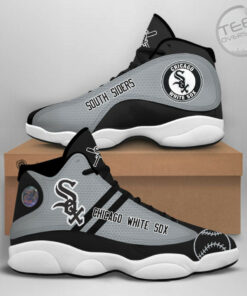
Chicago White Sox shoes – MLB sneakers
$95.95 – $95.98
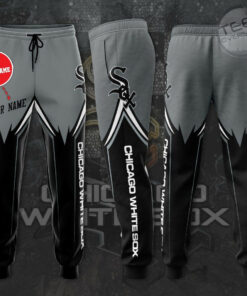
Chicago White Sox Sweatpant 3D – MLB Clothes
$45.95 – $45.98
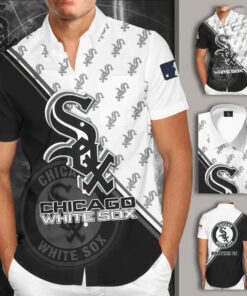
Chicago White Sox Short Sleeve Dress Shirt 3D – MLB Clothes
$35.95 – $35.98
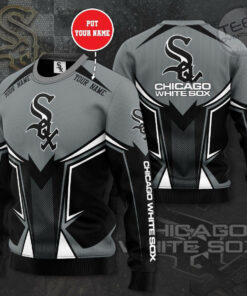
Chicago White Sox Sweatshirt 3D – MLB Clothes
$40.95 – $41.95
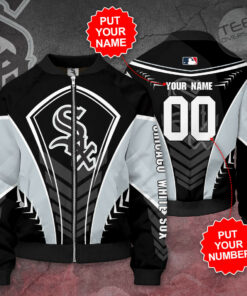
Chicago White Sox Bomber Jacket 3D – MLB Clothes
$54.95 – $54.98
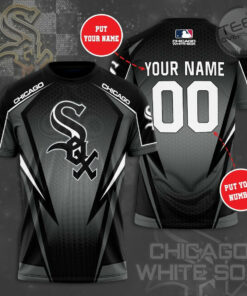
Chicago White Sox T-shirt 3D – MLB Clothes
$29.95

Chicago White Sox Hoodie 3D – MLB Clothes
$45.95 – $45.98
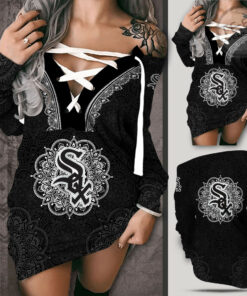
Chicago White Sox Off Shoulder Deep V-Neck Lace Up Long Sleeve Pullover – MLB Clothes
$45.95 – $48.95

Chicago White Sox Hollow Tank Top & Leggings – MLB Clothes
$69.95 – $72.95

Chicago White Sox Dashiki Dress – MLB Clothes
$45.95 – $48.95
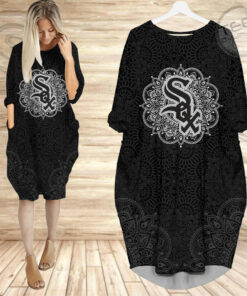
Chicago White Sox Batwing Pocket Dress – MLB Clothes
$49.95 – $52.95
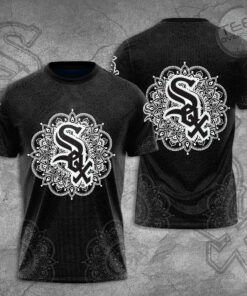
Chicago White Sox T-shirt – MLB Clothes
$29.95 – $32.95
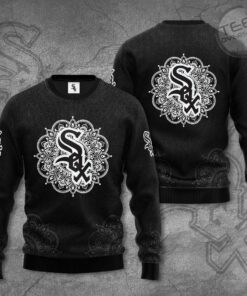
Chicago White Sox Sweatshirt – MLB Clothes
$40.95 – $43.95
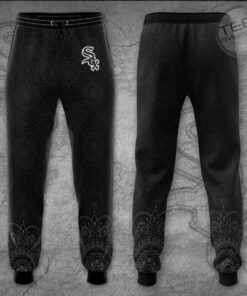
Chicago White Sox Sweatpant – MLB Clothes
$45.95 – $48.95
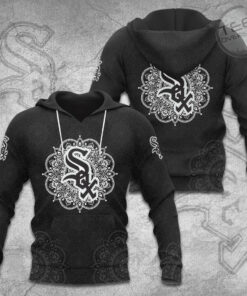
Chicago White Sox Hoodie – MLB Clothes
$45.95 – $48.95
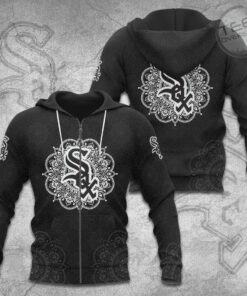
Chicago White Sox Zip-up Hoodie – MLB Clothes
$49.95 – $52.95
One of the American League's eight charter franchises, the White Sox were established as a major league baseball club in as the Chicago White Stockings, before shortening their name to the White Sox in. The team originally played their home games at South Side Park before moving to Comiskey Park in where they played until
. They moved into their current home, which was originally also known as Comiskey Park like its predecessor and later carried sponsorship from U.S. Cellular, for the 1991 season.
The White Sox won the 1906 World Series with a defense-oriented team dubbed "the Hitless Wonders", and the 1917 World Series, led by Eddie Cicotte, Eddie Collins and Shoeless Joe Jackson. The 1919 World Series was marred by the Black Sox Scandal, in which several members of the White Sox were accused of conspiring with gamblers to fix games. In response, the new MLB Commissioner Kenesaw Mountain Landis banned the players from the league for life. In 1959, the White Sox, led by Early Wynn, Nellie Fox, Luis Aparicio, and manager Al López, won the American League pennant. They won the AL pennant in 2005, and went on to win the World Series, led by MVP Jermaine Dye, Paul Konerko, Mark Buehrle, catcher A. J. Pierzynski, and Ozzie Guillén, the first Latino manager to win the World Series. The 87 years it took the White Sox to win the World Series stands as the second longest MLB championship drought of all time, with their crosstown rivals, the Chicago Cubs, holding the longest drought. The White Sox have an overall record of 9,411–9,309. Of the original sixteen teams prior to the expansion era, the White Sox have the least amount of league pennants with five.
History
The White Sox originated as the Sioux City Cornhuskers of the Western League, a minor league under the parameters of the National Agreement with the National League. In 1894, Charles Comiskey bought the Cornhuskers and moved them to St. Paul, Minnesota, where they became the St. Paul Saints. In 1900, with the approval of Western League president Ban Johnson, Charles Comiskey moved the Saints into his hometown neighborhood of Armour Square, where they became the Chicago White Stockings, the former name of Chicago's National League team, the Orphans.
In 1901, the Western League broke the National Agreement and became the new major league American League. The first season in the AL ended with a White Stockings championship. However, that would be the end of the season, as the World Series did not begin until 1903. The franchise, now known as the Chicago White Sox, made its first World Series appearance in 1906, beating the crosstown Cubs in six games.
The White Sox won a third pennant and a second World Series in 1917, beating the New York Giants in six games with help from stars Eddie Cicotte and "Shoeless" Joe Jackson. The Sox were heavily favored in the 1919 World Series, but lost to the Cincinnati Reds in eight games. Huge bets on the Reds fueled speculation that the series had been fixed. A criminal investigation went on in the 1920 season, and although all players were acquitted, commissioner Kenesaw Mountain Landis banned eight of them for life, in what was known as the Black Sox Scandal. This set the franchise back, as they did not win another pennant for 40 years.
The White Sox did not finish in the upper half of the American League again until after founder Charles Comiskey died and passed ownership of the club to his son, J. Louis Comiskey. They finished in the upper half most years between 1936 and 1946, under the leadership of manager Jimmy Dykes, with star shortstop Luke Appling and pitcher Ted Lyons, who both had their numbers 4 and 16 retired.
After J. Louis Comiskey died in 1939, ownership of the club was passed down to his widow, Grace Comiskey. The club was later passed down to Grace's children Dorothy and Chuck in 1956, with Dorothy selling a majority share to a group led by Bill Veeck after the 1958 season. Veeck was notorious for his promotional stunts, attracting fans to Comiskey Park with the new "exploding scoreboard" and outfield shower. In 1961, Arthur Allyn, Jr. briefly owned the club before selling to his brother John Allyn.
From 1951 to 1967, the White Sox had their longest period of sustained success, scoring a winning record for 17 straight seasons. Known as the "Go-Go White Sox" for their tendency to focus on speed and getting on base versus power hitting, they featured stars such as Minnie Miñoso, Nellie Fox, Luis Aparicio, Billy Pierce, and Sherm Lollar. From 1957 to 1965, the Sox were managed by Al López. The Sox finished in the upper half of the American League in eight of his nine seasons, including six years in the top two of the league. In 1959, the White Sox ended the New York Yankees' dominance over the American League, and won their first pennant since the ill-fated 1919 campaign. Despite winning game one of the 1959 World Series 11–0, they fell to the Los Angeles Dodgers in six games.
During the late 1960s and 1970s, the White Sox struggled to win games and attract fans. Allyn and Bud Selig agreed to a handshake deal that would give Selig control of the club and move them to Milwaukee, but it was blocked by the American League. Selig instead bought the Seattle Pilots and moved them to Milwaukee with the Oakland A's and St. Louis Cardinals, ending up in the Hall of Fame as the second-winningest manager of all time.
The White Sox struggled for the rest of the 1980s, as Chicago fought to keep them in town. Reinsdorf wanted to replace the aging Comiskey Park, and sought public funds to do so. When talks stalled, a strong offer was made to move the team to Tampa, Florida. Funding for a new ballpark was approved in an 11th-hour deal by the Illinois State Legislature on June 30, 1988, with the stipulation that it had to be built on the corner of 35th and Shields, across the street from the old ballpark, as opposed to the suburban ballpark the owners had designed. The new ballpark opened in 1991 under the name new Comiskey Park. The park, renamed in 2003 as U.S. Cellular Field and in 2016 as Guaranteed Rate Field, underwent many renovations in the early 2000s to give it a more retro feel.
The White Sox were fairly successful in the 1990s and early 2000s, with 12 winning seasons from 1990 to 2005. First baseman Frank Thomas became the face of the franchise, ending his career as the White Sox's all-time leader in runs, doubles, home runs, total bases, and walks. Other major players included Robin Ventura, Ozzie Guillén, Jack McDowell, and Bobby Thigpen. The Sox won the West division in 1993, and were in first place in 1994, when the season was canceled due to the 1994 MLB Strike.
In 2004, Ozzie Guillén was hired as manager of his former team. After finishing second in 2004, the Sox won 99 games and the Central Division title in 2005, behind the work of stars Paul Konerko, Mark Buehrle, A. J. Pierzynski, Joe Crede, and Orlando Hernández. They started the playoffs by sweeping the defending champion Boston Red Sox in the ALDS, and beat the Angels in five games to win their first pennant in 46 years, due to four complete games by the White Sox rotation. The White Sox went on to sweep the Houston Astros in the 2005 World Series, giving them their first World Championship in 88 years.
Guillén had marginal success during the rest of his tenure, with the Sox winning the Central Division title in 2008 after a one-game playoff with the Minnesota Twins. Guillén left the White Sox after the 2011 season and was replaced by former teammate Robin Ventura. The White Sox finished the 2015 season, their 115th in Chicago, with a 76–86 record, a three-game improvement over 2014. The White Sox recorded their 9,000th win in franchise history by the score of 3–2 against the Detroit Tigers on September 21, 2015. Ventura returned in 2016, with a young core featuring José Abreu, Adam Eaton, José Quintana, and Chris Sale. Ventura resigned after the 2016 season, in which the White Sox finished 78–84. Rick Renteria, the 2016 White Sox bench coach, was promoted to the role of manager.
Prior to the start of the 2017 season, the White Sox traded Sale to the Boston Red Sox and Eaton to the Washington Nationals for prospects including Yoán Moncada, Lucas Giolito and Michael Kopech, signaling the beginning of a rebuilding period. During the 2017 season, the White Sox continued their rebuild when they made a blockbuster trade with their crosstown rival, the Chicago Cubs, in a swap that featured the Sox sending pitcher José Quintana to the Cubs in exchange for four prospects headlined by outfielder Eloy Jiménez and pitcher Dylan Cease. This was the first trade between the White Sox and Cubs since the 2006 season.
During the 2018 season, relief pitcher Danny Farquhar suffered a brain hemorrhage while he was in the dugout between innings. Farquhar remained out of action for the rest of the season and just recently got medically cleared to return to baseball, despite some doctors doubting that he would make a full recovery. Also occurring during the 2018 season, the White Sox announced that the club would be the first Major League Baseball team to entirely discontinue use of plastic straws, in ordinance with the "Shedd the Straw" campaign by Shedd Aquarium. The White Sox broke an MLB record during their 100-loss campaign of 2018, but broke the single-season strikeout record in only a year after the Milwaukee Brewers broke the record in the 2017 season. On December 3, 2018, head trainer Herm Schneider retired after 40 seasons with t…
Eye-catching new design Chicago White Sox clothing will be the perfect gift for Chicago White Sox fans. Clothing on printed with unique and fancy designs, limited number of products.

Chicago White Sox shoes – MLB sneakers
$95.95 – $95.98

Chicago White Sox Sweatpant 3D – MLB Clothes
$45.95 – $45.98

Chicago White Sox Short Sleeve Dress Shirt 3D – MLB Clothes
$35.95 – $35.98

Chicago White Sox Sweatshirt 3D – MLB Clothes
$40.95 – $41.95

Chicago White Sox Bomber Jacket 3D – MLB Clothes
$54.95 – $54.98

Chicago White Sox T-shirt 3D – MLB Clothes
$29.95

Chicago White Sox Hoodie 3D – MLB Clothes
$45.95 – $45.98

Chicago White Sox Off Shoulder Deep V-Neck Lace Up Long Sleeve Pullover – MLB Clothes
$45.95 – $48.95

Chicago White Sox Hollow Tank Top & Leggings – MLB Clothes
$69.95 – $72.95

Chicago White Sox Dashiki Dress – MLB Clothes
$45.95 – $48.95

Chicago White Sox Batwing Pocket Dress – MLB Clothes
$49.95 – $52.95

Chicago White Sox T-shirt – MLB Clothes
$29.95 – $32.95

Chicago White Sox Sweatshirt – MLB Clothes
$40.95 – $43.95

Chicago White Sox Sweatpant – MLB Clothes
$45.95 – $48.95

Chicago White Sox Hoodie – MLB Clothes
$45.95 – $48.95

Chicago White Sox Zip-up Hoodie – MLB Clothes
$49.95 – $52.95
Comments
Post a Comment